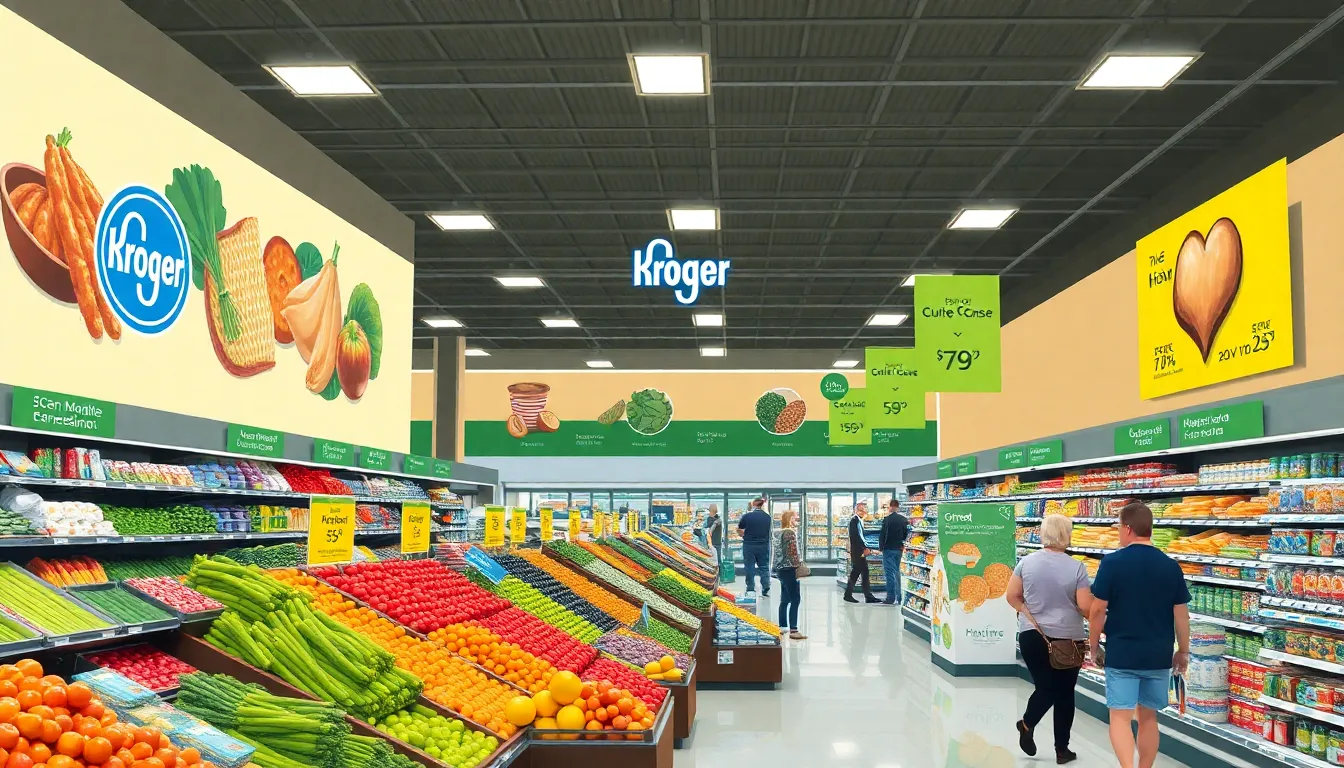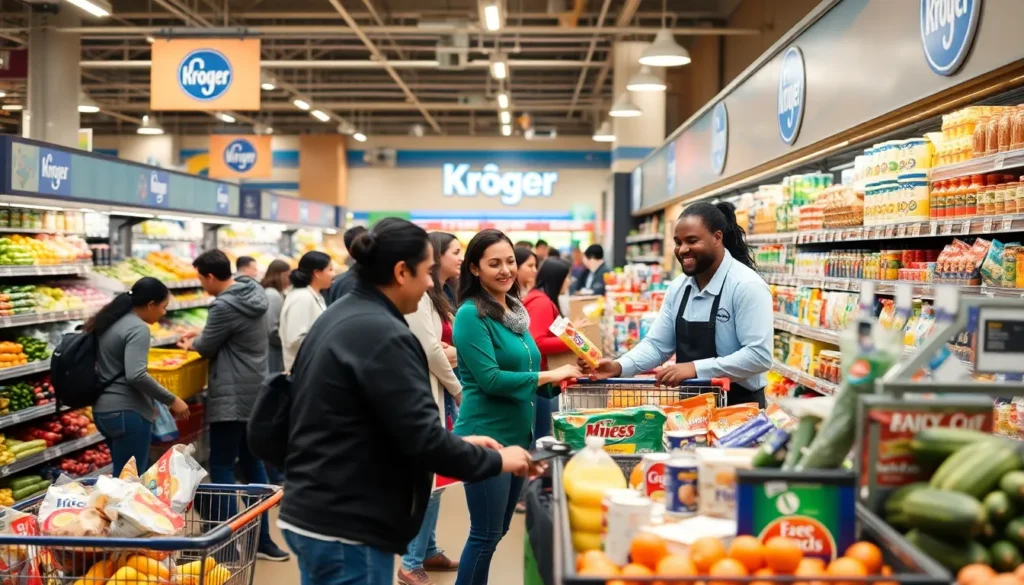Table of Contents
ToggleKroger, the grocery giant that’s practically a household name, has a presence that seems to multiply faster than rabbits in spring. With aisles stocked full of everything from fresh produce to gourmet snacks, it’s no wonder shoppers keep flocking to these stores. But just how many Kroger locations are there?
Overview of Kroger Stores
Kroger operates an extensive network of grocery stores across the United States. As of 2023, the company boasts over 2,700 locations, making it one of the largest supermarket chains in the country. Various formats characterize these stores, including traditional grocery stores, multi-department stores, and fuel centers.
Many Kroger stores double as platforms for a wide range of products. Customers find everything from fresh produce to household goods and pharmacy services. This diverse selection contributes to a robust shopping experience, attracting millions of shoppers each week.
In addition to its core grocery stores, Kroger has expanded into the e-commerce space. Online shopping options like delivery and pickup services cater to the growing demand for convenience. This approach aligns well with changing consumer preferences and enhances customer loyalty.
Kroger’s presence spans numerous states, making it a familiar name in many communities. Regional brands, including Ralphs, Fred Meyer, and Harris Teeter, also operate under the Kroger umbrella. Each brand adds to the overall count of stores, strengthening the company’s market position.
The company’s ongoing expansion strategy aims to reach even more customers. By opening new locations and innovating existing ones, Kroger continues to solidify its status in the grocery sector. Continued investment in technology and supply chain improvements further enhances its competitive edge.
With such a formidable number of locations, Kroger plays a crucial role in the U.S. grocery landscape. Steady growth and adaptation to market trends ensure its relevance in the ever-evolving retail environment.
Kroger Store Count by Year

Kroger’s growth reflects its commitment to expanding store locations. Throughout the years, this grocery chain has experienced significant increases in the number of stores.
Historical Growth
Kroger started with a single store in 1883. By 1940, the number had grown to over 1,500 locations. Expansion continued steadily, reaching 2,000 stores by 1990. In the early 2000s, Kroger acquired several regional grocery chains, boosting store counts. By 2010, Kroger operated more than 2,200 locations. This consistent upward trajectory highlights the company’s dedication to market presence.
Recent Data
As of 2023, Kroger operates more than 2,700 stores across the nation. The latest data indicates an ongoing strategy to open new locations and innovate existing ones. Each year, Kroger invests in technology and infrastructure to enhance store offerings. The expansion includes various formats, such as supermarkets and fuel centers. Regional brands under Kroger’s umbrella further contribute to total store counts. This comprehensive approach solidifies Kroger’s position as a leader in the grocery industry.
Geographic Distribution of Kroger Stores
Kroger’s extensive network spans multiple states across the United States. As a leader in the grocery sector, it plays a crucial role in many regional markets.
Store Locations by State
Kroger operates more than 2,700 stores, with a presence in multiple states. Texas has the highest concentration, with over 300 stores. Other significant states include Ohio and Michigan, each housing more than 200 locations. California also contributes to Kroger’s footprint through its subsidiary, Ralphs. This distribution ensures that Kroger meets diverse customer needs across urban and suburban areas.
Urban vs. Rural Presence
Kroger strategically positions its stores in both urban and rural settings. Urban areas benefit from smaller formats such as Kroger Express and City Market. These formats cater to high-density populations seeking convenience. Meanwhile, rural locations often feature larger, traditional grocery stores that serve broader communities. This approach balances accessibility with product variety, enabling Kroger to reach a wide customer base efficiently.
Comparing Kroger to Competitors
Kroger stands out in the grocery retail landscape alongside several major competitors.
Other Major Grocery Retailers
Walmart leads the grocery market with approximately 4,700 locations nationwide. Target follows closely with over 1,900 store formats offering grocery items. Costco operates about 600 warehouse locations that include grocery sections. Aldi, a discount grocer, has expanded to over 2,000 stores in the United States. Whole Foods Market, owned by Amazon, emphasizes organic products and boasts around 500 locations. These retailers provide a variety of grocery options, catering to diverse consumer preferences.
Market Share Analysis
Kroger holds a significant market share of about 10 percent, positioning it as the second-largest grocery chain in the U.S. Walmart maintains the top spot with an impressive share of 26 percent. Target captures around 3 percent, while Aldi and Costco each account for approximately 2 percent of the market. Market dynamics indicate that Kroger’s strategic investments and expansion efforts play a crucial role in its competitive stance. Regular updates and innovations help strengthen its position among grocery retailers.
Future Projections for Kroger Stores
Kroger plans to continue expanding its store network beyond its current reach of 2,700 locations. The strategy includes establishing new stores in underserved areas while modernizing existing locations to enhance shopping experiences. Investing in convenience also remains a priority; e-commerce options and improved technology will facilitate seamless customer interactions.
Current plans show significant growth potential in both urban and rural markets. By leveraging smaller formats in cities, Kroger can cater to denser populations, while larger stores in rural areas meet the needs of those communities effectively. Expansion efforts in Texas, Ohio, and Michigan will likely strengthen their already substantial presence in these states.
Research indicates Kroger aims to capture a larger market share in the evolving grocery landscape. As the second-largest grocery chain in the U.S., Kroger holds about 10 percent of the market, closely following Walmart’s 26 percent. With ongoing investments in technology and supply chain enhancements, Kroger’s competitive edge stands to improve significantly.
Innovation isn’t limited to physical stores; Kroger’s commitment to enhancing its online shopping platforms is crucial. Integrating advanced technologies for tracking inventory and streamlining delivery can further attract tech-savvy consumers. Partnerships with local brands, including regional grocery stores, may also enhance customer loyalty and product diversity.
By 2025, projections suggest Kroger could expand its store count significantly, ensuring it remains at the forefront of the grocery industry. These strategies position Kroger to adapt to shifting consumer preferences while maintaining a strong brand presence in the market.
Kroger’s impressive growth and strategic positioning in the grocery market underscore its commitment to serving diverse customer needs. With over 2,700 stores nationwide and a focus on both urban and rural communities, it effectively meets various shopping preferences. The company’s investments in technology and e-commerce reflect its adaptability to changing consumer behaviors.
As Kroger continues to expand and innovate, it remains poised to strengthen its market presence and enhance customer loyalty. The future looks bright for Kroger as it aims to capture more market share while providing quality products and services across its extensive network of stores.







